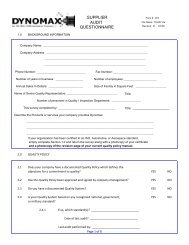You also want an ePaper? Increase the reach of your titles
YUMPU automatically turns print PDFs into web optimized ePapers that Google loves.
2.6 AC Variable Frequency Motor Drives<br />
AC drive operation begins with rectifying the alternating line voltage to produce DC. But because<br />
an AC motor is used, this DC voltage must then be changed back, or inverted, to an adjustablefrequency<br />
alternating voltage. The drive's inverter section accomplishes this. In years past, this<br />
was accomplished using SCRs. However, modern AC drives use a series of transistors to invert<br />
DC to adjustable-frequency AC.<br />
This synthesized alternating current is then fed to the motor at a frequency and voltage required<br />
to produce the desired motor speed. For example, a 60 Hz synthesized frequency, the same as<br />
standard line frequency in the United States, produces 100% of rated motor speed. A lower<br />
frequency produces a lower speed, and a higher frequency a higher speed. In this way, an AC<br />
drive specialized for the High Speed Spindles, can produce motor speeds from, approximately,<br />
15 to 5000% of a motor's normally rated RPM by delivering frequencies of 9 Hz to 3200 Hz,<br />
respectively.<br />
Today, AC drives are becoming the system of choice in many industries. Their use of simple and<br />
rugged three-phase induction motors means that AC drive systems are the most reliable and<br />
least maintenance prone of all. Plus, microprocessor advancements have enabled the creation of<br />
so-called vector drives, which provide greatly enhance ramp response down to zero speed and<br />
positioning accuracy.<br />
By far the most popular AC drive today is the pulse width modulated type. Though originally<br />
developed for smaller-horsepower applications, PWM is now used in drives with hundreds or<br />
even thousands of horsepower, as well as remaining the staple technology in the vast majority of<br />
small integral and fractional horsepower "micro" and "sub-micro" AC drives.<br />
Pulse width modulated refers to the inverter's ability to vary the output voltage to the motor by<br />
altering the width and polarity of voltage pulses. The voltage and frequency are synthesized<br />
using this stream of voltage pulses. This is accomplished through microprocessor commands to<br />
a series of power semiconductors that serve as on-off switches. Today, these switches are usually<br />
IGBTs, or isolated gate bipolar transistors. A big advantage of these devices is their fast<br />
switching speed resulting in higher pulse or carrier frequency, which minimizes motor noise.<br />
AC Drive Application Factors<br />
As PWM AC drives have continued to increase in popularity, drives manufacturers have spent<br />
considerable research and development effort to build in programmable acceleration and<br />
deceleration ramps, a variety of speed presets, diagnostic abilities, and other software features.<br />
Operator interfaces have also been improved with some drives incorporating "plainEnglish"<br />
readouts to aid set-up and operation. Plus, an array of input and output connections, plug-in<br />
programming modules, and off-line programming tools allow multiple drive set -ups to be<br />
installed and maintained in a fraction of the time spent previously. Some of the modern drives<br />
can be preset for different motors and user can easy switch connection on each of them with<br />
principle “one at a time”. On the other hand, a few motors with the same characteristics, can be<br />
used simultaneously with single drive. All these features have simplified drive applications.<br />
However, several basic points must be considered.<br />
- 22 -



